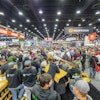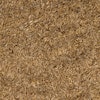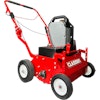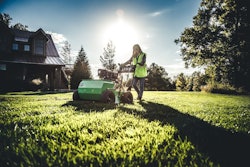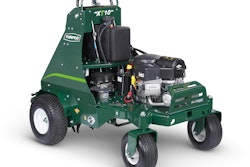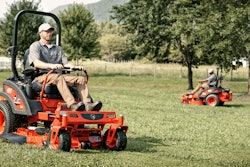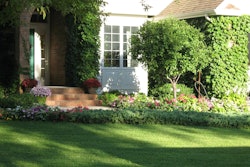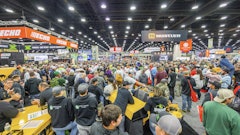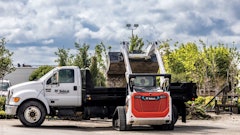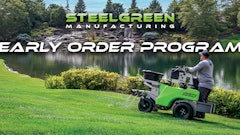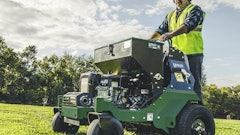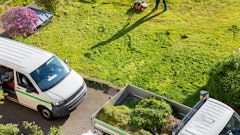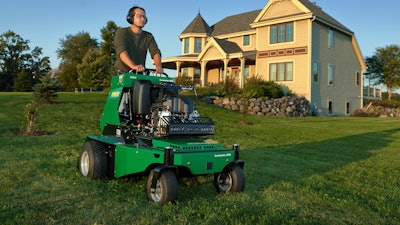
Walking, playing, and mowing stresses lawns over the course of a season. It is an important to give your customers’ lawns and properties the care and attention they need.
Aeration is an essential component of maintaining a healthy root system and growth of grass on a property. Understanding the best times and best equipment to get good results are crucial for landscapers to know.
Here’s a look at a few factors to consider on making the most of the aeration process.
Timing
The best time to aerate really depends on geography and grass type.
“Timing is very important for maximizing turf health so equipment operators should do their research based on grass type and seasons,” says Gina Putnam, director of sales and marketing Schiller Grounds Care, manufacturer of Classen Turf Care Products. “One definite recommendation: don’t aerate when grass is dormant, such as the winter months.”
A customer in the Northeast would aerate at a different time than others in the Southwest.
“The growing season of each grass type is usually the best time to aerate but the most important practice in improving turf health IS to aerate,” Putnam says. “Allowing air, water, and nutrients to pass through to the roots ensures they grow deeper and ultimately produce a stronger, more healthy lawn.”
If you have cool season turfgrass such as Kentucky bluegrass and perennial ryegrass, both spring and fall are ideal times to aerate.
Ron Scheffler, RYAN senior product manager, says in spring, aeration should be done between March and May.
“Perform fall aeration between August and November,” he says. “Aeration before or at the time of late season fertilization enhances root growth and improves spring green-up and growth.”
Conversely, for warm season grasses such as zyosia grass, Bermuda and St. Augustine, aeration is best in mid-spring to summer, or May to July.
Scheffler suggests avoiding aerating when warm season grasses are dormant, as it may encourage weed competition. In addition, he says avoid aerating warm season grasses during spring green-up, and not until after their first spring mowing. Reciprocating aerators, such as the Billy Goat PLUGR units provide the ability to achieve the same number of holes per square foot in single pass aeration as a drum unit can in two passes.Billy Goat
Reciprocating aerators, such as the Billy Goat PLUGR units provide the ability to achieve the same number of holes per square foot in single pass aeration as a drum unit can in two passes.Billy Goat
The right equipment
Aerators come in a vast array of options, from tow-behind to walk-behind to stand-on models. “When selecting an aerator, contractors should assess the types of properties they maintain,” Scheffler says. “The aeration season is a short one, so the right equipment is most important for a quick ROI.”
Reciprocating aerators are ideal for most properties due to their small size and flexibility. For larger properties, a drum or rotational aerator may be the best fit.
Brandon King, Billy Goat product manager, says reciprocating units provide the ability to achieve the same number of holes per square foot in single pass aeration as a drum unit can in two passes. He says they have variable aeration density which allows for 2 to 10x more holes per square foot in a single pass compared to a drum aerator. “Slowing the drive speed down increases the number of holes per square foot, increasing the amount of soil disturbed,” King says, adding that variable aeration density also permits patch and repair and seed prep in a single pass.
He also says turning with a reciprocating aerator vs. drum style increases maneuverability and reduces operator fatigue because the machine doesn’t have to be lifted to take the tines out of the ground when turning. This helps increase productivity and wear and tear on employees.
Scheffler says for larger open areas like homeowner estates, large commercial properties or sports field, tow-behind aerators are likely the most efficient. For smaller residential or commercial properties, a smaller stand-on or pedestrian (walk-behind) aerator will likely give you the best results and easiest maneuvering.
“If a contractor services a majority of properties with gates, a narrow aerator might be the best choice, in lieu of a wider one where a lot of time would be spent transporting,” Scheffler says. “Conversely, a stand-on aerator may be a wise choice, if one maintains larger wide-open spaces, for the best efficiency. They also take less of a toll on your body, maneuver easily, provide precise and easily adjustable aeration while also covering more ground than a walk-behind and doesn’t require a tractor like a tow behind aerator. Light kits or attachments should be looked at as well due to the shorter workdays in the spring and fall seasons.”
In addition to general style, Putnam says durability, ease of maintenance, and ease of use are the top considerations when selecting the right equipment.
“Aerators should offer a repeatable performance, regardless of the operators experience,” she says. “It is also important to consider from whom and where you are buying your aerator. You should always buy from a local, authorized dealer so that you have access to local service, parts, and warranty support. “
Ultimately, contractors must weigh the cost of a decision to buy and maintain aerators against rental time required to cover jobs. There is always the risk that rental units may not be available. King notes that the volume of jobs that need to be completed could justify a buy decision if there are not enough rental units available in the area. Classen offers drum and reciprocating aeration products, available in pedestrian style for compact spaces and stand-on style for larger spaces.Classen
Classen offers drum and reciprocating aeration products, available in pedestrian style for compact spaces and stand-on style for larger spaces.Classen
Successful process
“Aeration should not be done as a stand-alone agronomic practice,” Putnam says. “Mowing regularly, fertilizing during the appropriate seasons, watering when necessary, seeding for new growth, treating for weeds, diseases, and insects, and removing thatch will promote a healthy lawn.”
Prior to moving forward with any aeration, it is important to mark any obstacles on the property such as irrigation heads or any other power or cable lines that run just beneath the surface.
Also, King says to be sure to inspect the tines on your aerator to protect from doing a sub-par aeration job.
The order of your maintenance practices is also important for peak effectiveness.
“A landscaper should mow the lawn before aerating to maximize the effectiveness of aeration, and the lawn should be watered one to three days prior to aerating,” Scheffler says. “The lawn should be moist to allow the aerator tines to slip into the soil easier. Take care to not over water, though.”
He says during aeration, landscapers should take the time to ensure safety and proper operation. “Hurried work can lead to turf tear and improper machine use, which often leads to repairs to the lawn and equipment.
“If you’re planning to aerate and put down fertilizer/herbicide, make sure to aerate first,” Scheffler says.
Applying fertilizer after aeration helps the lawn compete against weeds. Aerating after an herbicide application can reduce the chemical barrier formed by the herbicide, giving weeds the opportunity to germinate.
Also, he encourages contractors to have their crews water the lawn after aeration too, particularly in areas where drought and high temperatures are common.
In terms of any drought, King notes that aeration should not be done during a drought or high heat times of season due to the possibility of the added stress to the lawn that would cause damage.
One criticism of aeration can be the presence of the cores or plugs on the turf that the aeration tines pull out of the ground.
“Remove cores if the lawn type will sustain damage from leaving the cores,” King says, referring to some warm season grasses, adding that most grasses are safe to leave the cores, which help return their nutrients back to the soil and serve as a vehicle for grass seed if overseeding.
Finally, if you are planning any over-seeding or inter-seeding, following aeration is a great time to put seed down as it will get better soil to seed contact. Specifically, King says to spend extra time on dead/bare areas to ensure seed to soil contact and better results.  The best time to aerate really depends on geography and grass type. Among the options are to use a drum-style aerator like the Ryan Lawnaire IV.RYAN
The best time to aerate really depends on geography and grass type. Among the options are to use a drum-style aerator like the Ryan Lawnaire IV.RYAN

